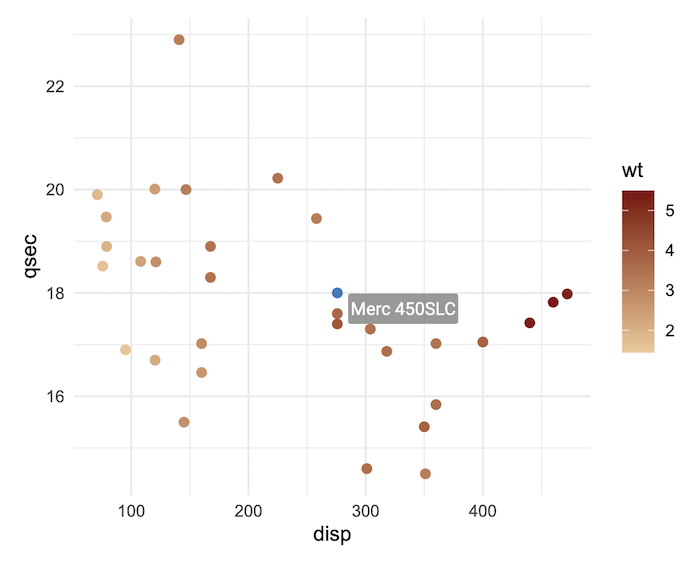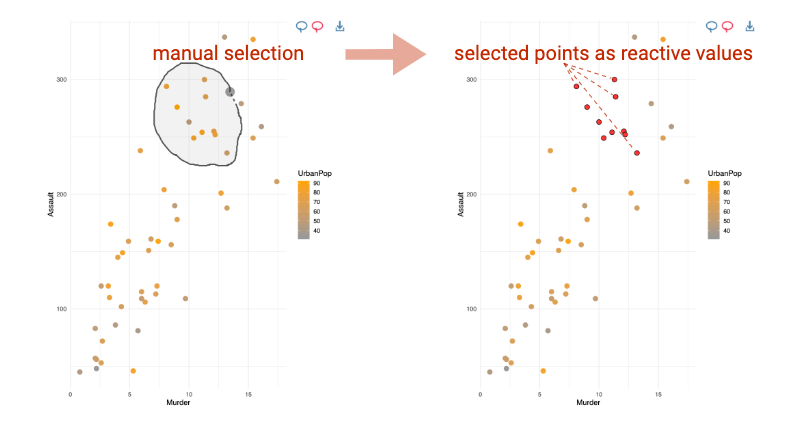The hardware and bandwidth for this mirror is donated by METANET, the Webhosting and Full Service-Cloud Provider.
If you wish to report a bug, or if you are interested in having us mirror your free-software or open-source project, please feel free to contact us at mirror[@]metanet.ch.
{ggiraph}makes ‘ggplot’ graphics interactive.

{ggiraph} is a tool that allows you to create dynamic
ggplot graphs. This allows you to add tooltips, hover effects and
JavaScript actions to the graphics. The package also allows the
selection of graphical elements when used in shiny applications.
Interactivity is added to ggplot geometries, legends and theme elements, via the following aesthetics:
tooltip: tooltips to be displayed when mouse is over
elements.onclick: JavaScript function to be executed when
elements are clicked.data_id: id to be associated with elements (used for
hover and click actions){ggiraph}{ggiraph} allows interaction
with graph elements, legends elements, titles and ggplot theme elements
from the server part; each selection is available as a reactive
value.
Under the hood,
{ggiraph}is an htmlwidget and a ggplot2 extension. It allows graphics to be interactive, by exporting them as SVG documents and using special attributes on the various elements.
The things you need to know to create an interactive graphic :
geom_point, use
geom_point_interactive, instead of using
geom_sf, use geom_sf_interactive… Provide at
least one of the aesthetics tooltip, data_id
and onclick to create interactive elements.girafe with the ggplot object so that the
graphic is translated as a web interactive graphics.library(ggplot2)
library(ggiraph)
data <- mtcars
data$carname <- row.names(data)
gg_point = ggplot(data = data) +
geom_point_interactive(aes(x = wt, y = qsec, color = disp,
tooltip = carname, data_id = carname)) +
theme_minimal()
girafe(ggobj = gg_point)data_id) can be selected and manipulated on client and
server sides. The list of selected values will be stored in in a
reactive value named [shiny_id]_selected.
They are several available interactive geometries, scales and other
ggplot elements. Almost all ggplot2 elements can be made interactive
with {ggiraph}. They are all based on their ggplot version,
same goes for scales and the few guides:
geom_point_interactive(),
geom_col_interactive(),
geom_tile_interactive(),
scale_fill_manual_interactive(),
scale_discrete_manual_interactive(),
guide_legend_interactive(), …
You can also make interactive annotations, titles and facets (see
help(interactive_parameters)).
Get development version on github
devtools::install_github('davidgohel/ggiraph')Get CRAN version
install.packages("ggiraph")The help pages are located at https://davidgohel.github.io/ggiraph/.
If you have questions about how to use the package, visit
Stackoverflow and use tags ggiraph and r Stackoverflow
link! We usually read them and answer when possible.
When you file a bug report, please spend some time making it easy for me to follow and reproduce. The more time you spend on making the bug report coherent, the more time I can dedicate to investigate the bug as opposed to the bug report.
A great way to start is to contribute an example or improve the documentation.
If you want to submit a Pull Request to integrate functions of yours, provide if possible:
inst/tinytest.By using rhub (run rhub::check_for_cran()), you will see
if everything is ok. When submitted, the PR will be evaluated
automatically with Github Action and you will be able to see if
something broke.
These binaries (installable software) and packages are in development.
They may not be fully stable and should be used with caution. We make no claims about them.